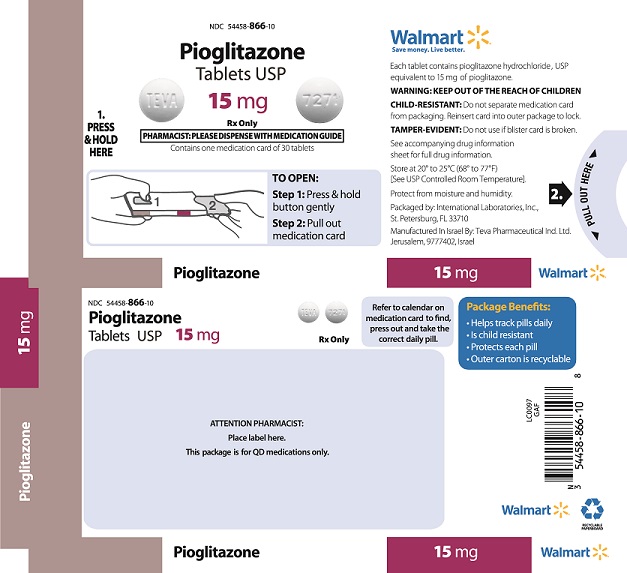![Pioglitazone Tablet [Sandoz Inc] Pioglitazone Tablet [Sandoz Inc]](/wp-content/themes/bootstrap/assets/img/loading2.gif)
2.1 Recommendations for All Patients
Pioglitazone tablets, USP should be taken once daily and can be taken without regard to meals.
The recommended starting dose for patients without congestive heart failure is 15 mg or 30 mg once daily.
The recommended starting dose for patients with congestive heart failure (NYHA Class I or II) is 15 mg once daily.
The dose can be titrated in increments of 15 mg up to a maximum of 45 mg once daily based on glycemic response as determined by HbA1c.
After initiation of pioglitazone tablets, USP or with dose increase, monitor patients carefully for adverse reactions related to fluid retention such as weight gain, edema, and signs and symptoms of congestive heart failure [see Boxed Warning and Warnings and Precautions (5.5)].
Liver tests (serum alanine and aspartate aminotransferases, alkaline phosphatase, and total bilirubin) should be obtained prior to initiating pioglitazone tablets, USP. Routine periodic monitoring of liver tests during treatment with pioglitazone tablets, USP is not recommended in patients without liver disease. Patients who have liver test abnormalities prior to initiation of pioglitazone tablets, USP or who are found to have abnormal liver tests while taking pioglitazone tablets, USP should be managed as described under Warnings and Precautions [see Warnings and Precautions (5.3) and Clinical Pharmacology (12.3)].
2.2 Concomitant Use with an Insulin Secretagogue or Insulin
If hypoglycemia occurs in a patient coadministered pioglitazone tablets, USP and an insulin secretagogue (e.g., sulfonylurea), the dose of the insulin secretagogue should be reduced.
If hypoglycemia occurs in a patient coadministered pioglitazone tablets, USP and insulin, the dose of insulin should be decreased by 10% to 25%. Further adjustments to the insulin dose should be individualized based on glycemic response.
2.3 Coadministration with Strong CYP2C8 Inhibitors
Coadministration of pioglitazone tablets, USP and gemfibrozil, a strong CYP2C8 inhibitor, increases pioglitazone exposure approximately 3-fold. Therefore, the maximum recommended dose of pioglitazone tablets, USP is 15 mg daily when used in combination with gemfibrozil or other strong CYP2C8 inhibitors [see Drug Interactions (7.1) and Clinical Pharmacology (12.3)].



![Pioglitazone Tablet [Teva Pharmaceuticals Usa Inc]](http://dailymed.nlm.nih.gov/dailymed/image.cfm?setid=c5c81c67-90cf-4e64-acb5-58b0358fa742&name=image-03.jpg)
![Pioglitazone Tablet [Mylan Institutional Inc.]](http://dailymed.nlm.nih.gov/dailymed/image.cfm?setid=612ee482-2236-4641-b782-649f4969a90d&name=airweld_hp_o2.jpg)
![Pioglitazone Tablet [Teva Pharmaceuticals Usa Inc]](http://dailymed.nlm.nih.gov/dailymed/image.cfm?setid=a3fcf590-64a7-4d6e-8b5a-ee637675f716&name=3c52f60a-9068-4606-8056-02cebd614d74-03.jpg)
![Pioglitazone Tablet [Ranbaxy Pharmaceuticals Inc.]](http://dailymed.nlm.nih.gov/dailymed/image.cfm?setid=0478f0e7-87fb-4adb-ae9b-6624555ccbe4&name=a2a31eaf-b314-445c-a7dd-42a363a04092-03.jpg)
![Pioglitazone Tablet [Ranbaxy Pharmaceuticals Inc]](http://dailymed.nlm.nih.gov/dailymed/image.cfm?setid=f4c5d4ea-3fa9-4c7b-80eb-d1f1edbbac16&name=15mg-container.jpg)
![Pioglitazone Tablet [Medvantx, Inc.]](http://dailymed.nlm.nih.gov/dailymed/image.cfm?setid=a3ae5cba-f495-4593-b8fc-5ada34790745&name=a3ae5cba-f495-4593-b8fc-5ada34790745-03.jpg)
![Pioglitazone Tablet [Clinical Solutions Wholesale]](http://dailymed.nlm.nih.gov/dailymed/image.cfm?setid=6c6f14bb-c964-42a6-93a6-192204ae1b99&name=6c6f14bb-c964-42a6-93a6-192204ae1b99-03.jpg)
![Pioglitazone Tablet [Mylan Pharmaceuticals Inc.]](http://dailymed.nlm.nih.gov/dailymed/image.cfm?setid=5a50d22e-acbe-4b15-9ed6-70713378408a&name=4077872_05-01.jpg)
![Pioglitazone Tablet [International Labs, Inc.]](http://dailymed.nlm.nih.gov/dailymed/image.cfm?setid=0beaf7da-fe4b-65cb-e054-00144ff88e88&name=L919-0914.jpg)
![Pioglitazone Tablet [American Health Packaging]](http://dailymed.nlm.nih.gov/dailymed/image.cfm?setid=99930370-0a84-40a5-89ab-d87bbb062e77&name=99930370-0a84-40a5-89ab-d87bbb062e77-03.jpg)
![Pioglitazone Tablet [Macleods Pharmaceuticals Limited]](http://dailymed.nlm.nih.gov/dailymed/image.cfm?setid=482cef76-0623-4b4f-a0ea-f008c97b2281&name=pioglitazone-15mg-30s.jpg)
![Pioglitazone Tablet [Sandoz Inc]](http://dailymed.nlm.nih.gov/dailymed/image.cfm?setid=5e36173a-2b5f-4ed7-bf81-6e79d78df0c4&name=3c41c6c7-f1f3-40cb-87dc-d98716a7f858-03.jpg)
![Pioglitazone Tablet [Carilion Materials Management]](http://dailymed.nlm.nih.gov/dailymed/image.cfm?setid=f4ca7537-ed49-4dee-9003-48dc001a9dc1&name=68151-3792.jpg)
![Pioglitazone Tablet [Carilion Materials Management]](http://dailymed.nlm.nih.gov/dailymed/image.cfm?setid=7547c308-3c83-429c-b761-0610d775317d&name=68151-3798.jpg)